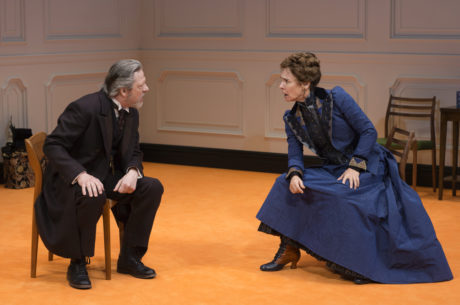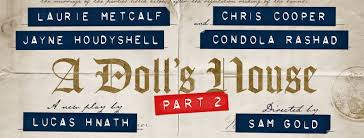In 1982 a distinguished group of Broadway pros, including Hal Prince, Betty Comden and Aldolph Green, came up with what was then thought to be a misbegotten idea: what happened to Nora Helmer after she slammed the door in Henrik Ibsen’s play and left her “doll’s house”, the one she shared with her husband Torvald and their three children? That musical sequel to Ibsen’s play opened at the Mark Hellinger Theatre, played 5 performances and folded, not to be heard from again.
Now, thirty five years later Lucas Hnath, an experienced regional and off Broadway playwright (The Christians, Red Speedo) has dared to have Ibsen’s Nora begin his play by knocking (more accurately, banging) on the same door. When it is finally opened by Anne Marie, the nanny Nora left behind fifteen years earlier, and Laurie Metcalf strides through it as though she owned the place, we know we needn’t have worried about how she fared out there in the real world. But we do wonder what brought her back on this particular day.

Mr. Hnath’s fascinating and often funny (yes, funny!) play allows four gifted actors a chance, in the next ninety minutes, to surprise and delight us as they each find the words with which to explain their very different views of what Nora’s departure meant to each. Though Nora meets each argument with a forceful one of her own, no one wins in this very involving debate. For starters, Ms. Metcalf’s Nora is not the one who left all those years ago. She learned quickly how cruel reality can be, but with growing realization of what she’d allowed her husband Torvald to mold her into, and she has become a writer of popular women’s novels and an experienced lover. She doesn’t seem to care that she’s become a most dominating female who will continue to cause havoc.
During this sudden visit, she reveals she needs something from Torvald to which she feels entitled, and Ms. Metcalf’s scenes with Chris Cooper, are written and played with the kind of fire more reminiscent of Alice and Edgar in The Dance of Death than of Ibsen’s Nora and Torvald. The revelation of Mr. Hnath’s play is that, stripped of the pretense that kept their marriage afloat in its early days, these two vividly drawn characters are vital, real and totally unsuited to each other as marriage partners.
Jayne Houdyshell is “Anne Marie”, the faithful retainer who has spent the past 15 years raising the three children whom Nora had abandoned. Ms. Houdyshell, a late blooming Tony Award-winner (most recently, for The Humans) is resourceful and equally combative when she’s given the eloquent words her playwright has handed her. She delivers them sometimes with humor, sometimes with great rage.
Nora’s oldest daughter Emmy is a teenager, a proper young lady whose posture, deportment and calm cool composure indicate the care with which she’s been educated. But even though she’d had creature comforts, she’d been a motherless young girl when Nora left, and that loss has made her strong, resolute and capable of expressing anger, made surprising by its cool delivery. It enables her to refuse Nora’s ferocious attempt to reconcile with her.
Sam Gold’s direction has always been interesting and sometimes controversial. His firm hand was certainly visible in two recent productions: Fun Home and The Glass Menagerie. He brings contemporary attitudes and post-Freudian behavior into material that is set earlier than the times when psychiatry explained a lot. He and Mr. Hnath have injected contemporary slang into the play; it brings the laughter of shock and is part of their plan to make the play more accessible to today’s audiences.
Condola Rashad, who made her debut with a dynamite performance in Ruined, is deliciously controlled in her scenes with her mother. Sparks do indeed fly as this mother and daughter have at each other, evenly matched in their convictions, both unable or unwilling to compromise.

Miriam Buether’s design for the drawing room of the Helmer house in which the play is performed is worth comment. We are told that all of Nora’s personal belongings have been removed, but they haven’t been replaced, so we have a very large room with four chairs, a table, a lamp, very little furniture as a constant reminder that Mom is gone. The costumes, in contrast to the vernacular in the dialog, are strictly period, and they are rich in detail. Nora’s gown looks stylish and expensive and tells us much about her rise in the outside world, Torvald’s suit presents him as the hard nosed middle class citizen he really is. Daughter Emmys conservative black dress is proper and becoming. Anne Marie’s practical and unstylish working clothes give added weight to Jayne Houdyshell’s wise performance of a simple good woman.
It’s been a season jam packed with fine work by actors and writers, particularly in the area of new plays. A Doll’s House, Part 2 ranks high amongst the best of the season. I hope one day it appears in repertory with its source, Ibsen’s A Doll’s House. What a field day it would be for actors of the range of Laurie Metcalf and Chris Cooper to play Nora and Torvald one night at age 30, the next night at 45. Perhaps it could be joined by the current production of The Little Foxes, in which two actresses are alternating in the two leading lady roles. Both plays contain a young character, a teenage girl who is growing into a strong force capable of combating an implacable mother.
Running Time: 90 minutes, with no intermission.
A Doll’s House, Part 2 plays a limited 11-week engagement through July 30, 2017, at the Golden Theatre – 252 West 45th Street, in New York, NY. For tickets, call (212) 239-6200, or go online.





